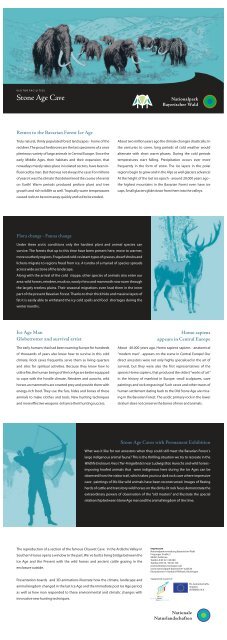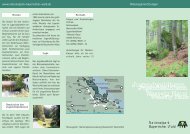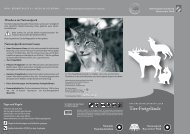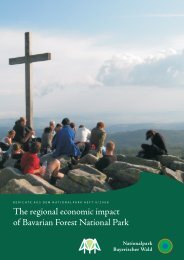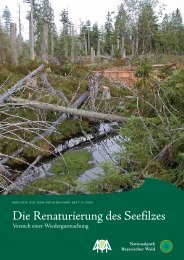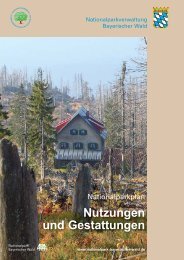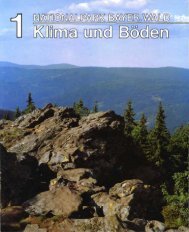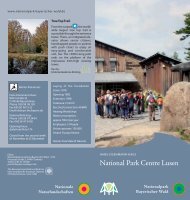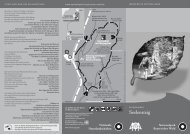Flyer Stone Age Cave - Nationalpark Bayerischer Wald
Flyer Stone Age Cave - Nationalpark Bayerischer Wald
Flyer Stone Age Cave - Nationalpark Bayerischer Wald
You also want an ePaper? Increase the reach of your titles
YUMPU automatically turns print PDFs into web optimized ePapers that Google loves.
VISITOR FACILITIES<br />
<strong>Stone</strong> <strong>Age</strong> <strong>Cave</strong><br />
Return to the Bavarian Forest Ice <strong>Age</strong><br />
Truly natural, thinly populated forest landscapes - home of the<br />
red deer. The proud herbivores are the last specimens of a once<br />
plenteous variety of large animals in Central Europe. Since the<br />
early Middle <strong>Age</strong>s, their habitats and their expansion, that<br />
nowadays merely takes place in isolated sectors, have been influenced<br />
by man. But that was not always the case! For millions<br />
of years it was the climate that determined the course of events<br />
on Earth! Warm periods produced profuse plant and tree<br />
growth and rich wildlife as well. Tropically warm temperatures<br />
caused rocks to be worn away quickly and soil to be eroded .<br />
Flora change - Fauna change<br />
Under these arctic conditions only the hardiest plant and animal species can<br />
survive. The forests that up to this time have been present here, move to warmer,<br />
more southerly regions. Frugal and cold-resistant types of grasses, dwarf shrubs and<br />
lichens migrate to regions freed from ice. A tundra of a myriad of species spreads<br />
across wide sections of the landscape.<br />
Along with the arrival of the cold steppe, other species of animals also enter our<br />
area: wild horses, reindeer, musk ox, wooly rhino and mammoth now roam through<br />
the largely treeless plains. Their seasonal migrations even lead them in the inner<br />
part of the present Bavarian Forest. Thanks to their thick hide and massive layers of<br />
fat it is easily able to withstand the icy cold spells and food shortages during the<br />
winter months.<br />
Ice <strong>Age</strong> Man<br />
Globetrotter and survival artist<br />
The early humans that had been roaming Europe for hundreds<br />
of thousands of years also knew how to survive in this cold<br />
climate. Rock caves frequently serve them as living quarters<br />
and sites for spiritual activities. Because they know how to<br />
utilise fire, the human beings of the Ice <strong>Age</strong> are better equipped<br />
to cope with the hostile climate. Reindeer and aurochs, wild<br />
horses an mammoths are coveted prey and provide them with<br />
energy-rich food. They use the furs, hides and bones of these<br />
animals to make clothes and tools. New hunting techniques<br />
and more effective weapons enhance their hunting success.<br />
The reproduction of a section of the famous Chauvet <strong>Cave</strong> in the Ardèche Valley in<br />
Southern France opens a window to the past. We`ve built a living bridge between the<br />
Ice <strong>Age</strong> and the Present with the wild horses and ancient cattle grazing in the<br />
enclosure outside.<br />
Presentation boards and 3D animations illustrate how the climate, landscape and<br />
animal kingdom changed in the last Ice <strong>Age</strong> and the immediate post Ice <strong>Age</strong> period,<br />
as well as how man responded to these environmental and climatic changes with<br />
innovative new hunting techniques.<br />
About two million years ago the climate changes drastically: In<br />
the centuries to come, long periods of cold weather would<br />
alternate with short warm phases. During the cold periods<br />
temperatures start falling. Precipitation occurs ever more<br />
frequently in the form of snow. The ice layers in the polar<br />
regions begin to grow and in the Alps as well glaciers advance!<br />
At the height of the last ice epoch - around 20.000 years ago -<br />
the highest mountains in the Bavarian Forest even have ice<br />
caps. Small glaciers glide down from them into the valleys.<br />
Homo sapiens<br />
appears in Central Europe<br />
About 40.000 years ago, Homo sapiens sapiens - anatomical<br />
“modern man” - appears on the scene in Central Europe! Our<br />
direct ancestors were not only highly specialised in the art of<br />
survival, but they were also the first representatives of the<br />
species Homo sapiens, that produced the oldest “works of art”<br />
in the history of mankind in Europe: small sculptures, cave<br />
paintings and rock engravings! Such caves and other traces of<br />
human settlement dating back to the Old <strong>Stone</strong> <strong>Age</strong> are missing<br />
in the Bavarian Forest. The acidic primary rock in the lower<br />
stratum does not conserve the bones of men and animals.<br />
<strong>Stone</strong> <strong>Age</strong> <strong>Cave</strong>s with Permanent Exhibition<br />
What was it like for our ancestors when they could still meet the Bavarian Forest`s<br />
large indigenous animal fauna? This is the thrilling situation we try to recreate in the<br />
Wildlife Enclosure Area (Tier-Freigelände) near Ludwigsthal. Aurochs and wild horses -<br />
imposing hoofed animals that were indigenous here during the Ice <strong>Age</strong>s can be<br />
observed from the visitor trail, which takes you to a dark rock cave where impressive<br />
cave paintings of life-like wild animals have been reconstructed. Images of fleeing<br />
herds of cattle and transitory wild horses on the dimly-lit rock faces demonstrate the<br />
extraordinary powers of observation of the “old masters” and illustrate the special<br />
relationship between <strong>Stone</strong> <strong>Age</strong> man and the animal kingdom of the time.<br />
Impressum<br />
<strong>Nationalpark</strong>verwaltung <strong>Bayerischer</strong> <strong>Wald</strong><br />
Freyunger Straße 2<br />
94481 Grafenau<br />
Telefon 0 85 52 / 96 000<br />
Telefax 0 85 52 / 96 00 100<br />
poststelle@npv-bw.bayern.de<br />
www.nationalpark-bayerischer-wald.de<br />
Illustrationen © Burkard Pfeifroth, Reutlingen<br />
Supported as part of<br />
EU-Gemeinschaftsinitative<br />
INTERREG III A
STONE AGE CAVE<br />
The Horse Panel<br />
from the Chauvet <strong>Cave</strong>, Southern France<br />
On 18th December 1994, a few cavers in the Ardèche<br />
region of Southern France couldn't believe their eyes.<br />
They had just made a sensational discovery - the Chauvet<br />
<strong>Cave</strong> with the oldest known cave paintings in world to<br />
date. The age and advanced artistic quality of these<br />
representations put current assumptions regarding the<br />
origins of art into question. Featuring scuffling rhinoceros,<br />
wild horses, bison, lions and a herd of wild aurochs, the six<br />
meter long "Horse Panel" in the Chauvet <strong>Cave</strong> is<br />
considered a masterpiece of pre-historic art.To the right, a<br />
cave lion sniffs the rear of a crouching companion. Both<br />
animals belong to an extinct, mane-less species and are<br />
possibly about to mate. These are just two of the<br />
numerous paintings in the Ardèche cave that were<br />
created probably over 35,000 years ago and bear amazing<br />
witness to the creativity of Old <strong>Stone</strong> <strong>Age</strong> man.<br />
Given their enormous value for research into the history of<br />
mankind, the treasures of the Chauvet <strong>Cave</strong> are not open<br />
to the public. That's why we invite you to visit the<br />
reconstructed "<strong>Stone</strong> <strong>Age</strong> <strong>Cave</strong>" at the entrance to the<br />
Wildlife Enclosure Area (Tier-Freigelände) near Ludwigsthal<br />
where you can admire a small piece of this pre-historic art<br />
treasure up close.<br />
You can take a virtual tour of the original cave on the<br />
Internet at: www.culture.fr/culture/arcnat/chauvet.


